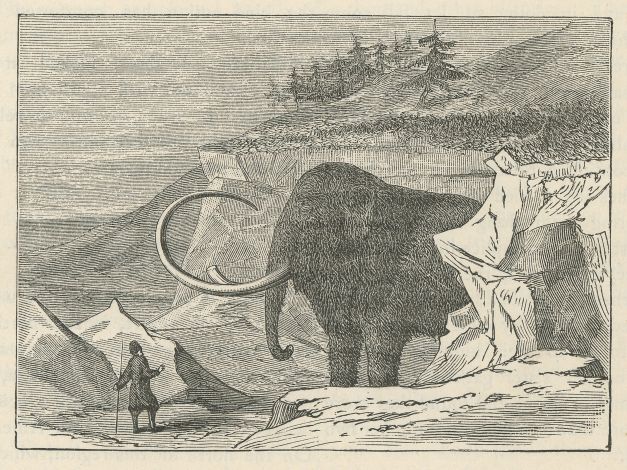“The Mammoth” (reprinted from Young Folks’ News; from The Children’s Friend [West Chester, Pennsylvania], Twelfth month 1871; pp. 379-381)
There is a vast country, of which Siberia forms a part, in the north of Asia, stretching from the mountains which separate Europe from Asia, and reaching as far as the straits which are between that continent and America. On the north of this region, which is larger than Europe, is the Polar Sea; and the great mountains—whose southern chain, the Himalayas, contains the highest peaks in the world—bound it on the south.
It is a dreary land, high and rocky on the south, and flat and frozen to the north. In the year 1799 a chief of a native tribe was searching for ivory along the banks of the Lena, when, to
-----
p. 380
his great horror and fright, he saw in a cliff of the gravel just mentioned a huge block of ice, and in it what he considered a beast of evil omen. He became ill from terror, but, on his recovery, remembering that the beast had tusks which were like those he was searching for, he again visited the spot. There stood, all encased in transparent ice, a creature like an elephant in shape, nine feet high and sixteen long, and with enormous tusks projecting for eight or ten feet, and curving at their tips. The huge brute was hairy; it had long black bristles all over it, and they were from a foot to sixteen inches long; it had also long red hair covering the whole body, and short fur. The chief waited

and watched for five years. By the end of that time the ice had melted, and the mammoth presented itself in its flesh and hairy hide to the astonished natives. The tusks were cut off and sold, the neighboring inhabitants came with their dogs and feasted on the carcase, and the wolves picked the bones. Fortunately, a naturalist heard of it, and collected the bones and specimens of the hair, thirty pounds weight of which were gathered from the wet sand bank on which the mammoth rested, and the tusks he re-purchased. He carried the whole to the nearest capital, St. Petersburg, a distance of 7,330 miles, where it became one of the Wonders of the World, and where it may still be seen
-----
p. 381
in the museum of which it forms a most remarkable feature, Our illustration shows the gigantic carcase as it appeared to the astonished eyes of the chief, still half-encased in the ice block which had preserved it for so many years.
It is supposed that the mammoth lived amongst the forests of the great plain of Siberia, and that it was often overtaken by floods, and drowned.—Young Folks’ News.